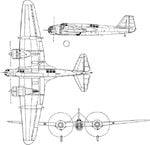- Thread starter
- #61
CharlesBronson
Senior Master Sergeant
Nudelman Suranov NS-23.
1944 design. In order to replace the VYa 23 gun in the new generation of fighters and shturmoviks, the main objetive in the NS 23 was to increase the rate of fire and to made a gun compatible with synchronization devices.
Nudelman Suranov adapted their short recoil operation to the new shorter cartrigde giving a increased ciclic rate of fire between 600-650 rpm.
A total control of the firing pin during automatism allowed the cannon to be coupled with interruption gears in single engine fighters.
Its only disandvantage was the reduce muzzle velocity compared with the earlier 23 mm model, however as the NS 23 was not proposed as anti-armor weapon this was felt irrelevant by the VVS. ( as I said before the antitank work was taken in late war by specialized bombs and rockets)

NS 23 compared with the shorter Shvak.

4 x NS 23 in wings, Ilyushin Il-10

The NS 23 was adapted by several late war and post war aircraft such as: MiG-9, Yakovlev Yak-7U, Yak-9U, Yak-15, Yak-17, and Yak-23 Il-10, Il-18, Il-20 ( fixed) Lavochkin La-9 and La-11 ( synchro) and defensive in Ilyushin Il-22.
The manufacturing of NS 23 ended in 1950.
Il-22 rear emplacement.

NS-23 characteristics:
Action: short recoil rotating bolt head. Counterrecoil by helicoidal spring and Hydropneumatic cilinder.
Charging: pneumatical
Lenght: 2230 mm
Weight: 37 kg
Rate of fire: 600-650 ( 500 rpm in La-9 and La-11)
Muzzle velocity: 685-710 m/s
3 x NS 23 in the nose (lavochkin La-9)

1944 design. In order to replace the VYa 23 gun in the new generation of fighters and shturmoviks, the main objetive in the NS 23 was to increase the rate of fire and to made a gun compatible with synchronization devices.
Nudelman Suranov adapted their short recoil operation to the new shorter cartrigde giving a increased ciclic rate of fire between 600-650 rpm.
A total control of the firing pin during automatism allowed the cannon to be coupled with interruption gears in single engine fighters.
Its only disandvantage was the reduce muzzle velocity compared with the earlier 23 mm model, however as the NS 23 was not proposed as anti-armor weapon this was felt irrelevant by the VVS. ( as I said before the antitank work was taken in late war by specialized bombs and rockets)
NS 23 compared with the shorter Shvak.

4 x NS 23 in wings, Ilyushin Il-10
The NS 23 was adapted by several late war and post war aircraft such as: MiG-9, Yakovlev Yak-7U, Yak-9U, Yak-15, Yak-17, and Yak-23 Il-10, Il-18, Il-20 ( fixed) Lavochkin La-9 and La-11 ( synchro) and defensive in Ilyushin Il-22.
The manufacturing of NS 23 ended in 1950.
Il-22 rear emplacement.

NS-23 characteristics:
Action: short recoil rotating bolt head. Counterrecoil by helicoidal spring and Hydropneumatic cilinder.
Charging: pneumatical
Lenght: 2230 mm
Weight: 37 kg
Rate of fire: 600-650 ( 500 rpm in La-9 and La-11)
Muzzle velocity: 685-710 m/s
3 x NS 23 in the nose (lavochkin La-9)












